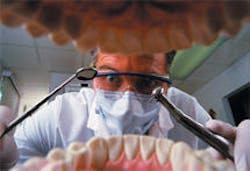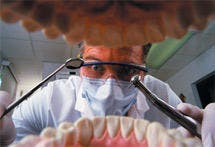You need more than a sharp explorer!
by Joe Blaes, DDS
Proper case planning depends on accurate — and early — diagnosis. New products exist that can significantly enhance detection and treatment of decay.
When I graduated from dental school, we were taught to diagnose decay by visually examining a tooth and probing suspicious pits and fissures with a sharp explorer. If the explorer would catch, you knew that the decay had gone through the enamel and that the tooth needed to be restored. In those days, we also used an X-ray film that required a fairly long exposure. We became experts at modifying the exposure to increase the intensity of the black, white, and gray tones on the film. You could actually see decay on the X-ray.
Diagnosis of the presence of caries in teeth was fairly simple in those days. Fluoride existed only in areas where it occurred naturally, so decay was rampant. It was not unusual to have 15 surfaces of decay to restore on a child, only to have the same child return with decay on another six to 10 surfaces six months later. That was the so-called "Golden Age of Dentistry." We used to call it "Drill, Fill, and Bill" dentistry. When fluoride was introduced into municipal water systems and into toothpaste, rampant decay began to disappear.
Some pedodontists have told me that they are seeing a resurgence of decay that they feel is due to the large amounts of sugar that children are consuming, particularly in the form of sticky products like "fruit rollups." Be sure that you educate your patients so they can help 0children avoid some of these products.
Some researchers believe that fluoride also has caused some remineralization in teeth, which makes pits and fissures harder to probe for decay. Leaders in the field of caries research agree that the usual methods of diagnosing decay are inadequate and outdated for the modern dentist. Even for an experienced clinician like myself, it is hard to diagnose decay with an explorer (even an extremely sharp one).
We all know that it is more difficult to diagnose decay on X-ray film. The contrast is lacking in most films. The new InSight film from Kodak is an exception to this trend. As a clinician, I have been searching for new and better ways to diagnose decay so that I can properly treatment-plan early detection and restoration.
I know that some dentists do not believe in early detection and early restoration of these pits and fissures. Some dentists advise that we should simply honor that time-tested procedure of "watching" these teeth and restoring them when they exhibit symptoms. If you have the opportunity, I would encourage you to listen to Dr. Rella Christensen speak on "Undetected Decay." I was fascinated by what her research has uncovered.
Of course, insurance carriers would have you believe that early detection is not supported by evidence. They claim that evidence-based dentistry indicates that dentists should "watch" these teeth rather than restore them. I am sure that endodontists would like to see you do this. Please understand that if you begin restoring more of these teeth, chances are very high that you will become a marked person. At least one insurance carrier will tell you (and probably your patient) that you no longer fit their "profile." There are consequences!
Everyone agrees that proper treatment planning depends upon accurate diagnosis. Since the accuracy of detecting occlusal and interproximal decay can be difficult, new methods must be considered. The visual and radiographic evaluation that you have relied on for years can be enhanced significantly by the use of the new DIAGNOdent caries detection system by KaVo.
DIAGNOdent is the culmination of years of clinical research in which the primary goal was to improve and simplify evaluation of undetected decay. With this product, you can combine your qualitative evaluation with a reliable method of quantifying disease progression. Improved diagnostic accuracy and early intervention are major benefits.
The KaVo DIAGNOdent is a reliable, noninvasive tool that is highly effective in detecting decay at an early stage. It is a Class-II laser that safely reflects a light beam off of the occlusal surface and records the resulting data into specific grades of caries development. Dentists can now properly assess intraenamel lesions as well as those that have gone into the dentin. Early treatment of these lesions will be of great benefit to patients.
Before using this instrument, you must thoroughly clean the teeth that you will be evaluating. This is particularly true for smokers. I believe that it is important to introduce patients to this new diagnostic tool by showing them what it does and how it works. I want them to understand the significance of the numbers that will appear on the screen. They need to know which numbers represent a dangerous situation so that there will be no question of what we need to do when that number comes up.
I have talked to many dentists who use this approach daily, and they are excited to have this technology. Some feel that they have been able to help their patients avoid endodontic treatment because of early detection of a carious lesion. These dentists are providing a very valuable service to their patients.
I spoke with Dr. Lori Trost, who practices in Columbia, Ill. She is very enthusiastic about improving her diagnostic skills. Dr. Trost said, "I think that the DIAGNOdent is a must in every dental practice. We use it on every patient along with the explorer and radiographs. On a daily basis, we encounter teeth that we normally would ignore, but once these teeth are "opened up" by this instrument, we find that they are carious. It is an amazing diagnostic tool that leads to more conservative dentistry with earlier detection and treatment."
So, now we have a new tool to add to our armamentarium that allows us to become even better at what we do on a daily basis — diagnose decay. Combined with our conventional diagnostic tools and professional judgment, we have established a new foundation for minimally invasive dentistry.
Along with our diagnostic tools, there are some exciting clinical tools to help do great restorative dentistry. I use an electric handpiece when I cut on teeth. This handpiece, combined with an SS White Fissurotomy bur, allows me to quickly do quality, minimally invasive dentistry without the hassle of changing handpieces. This bur now comes in three sizes that are inexpensive and cut quickly, especially with the electric handpiece. Since there is very little vibration or heat generated, most of this dentistry is done without anesthesia.

